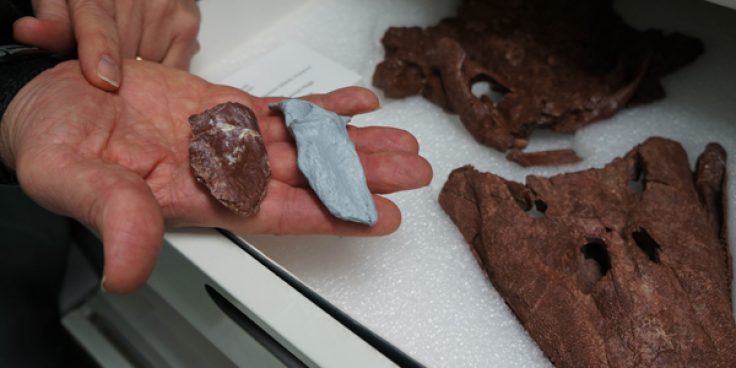375-Million-Year-Old Fish Fossil Reveals How Hind Legs Evolved, Tiktaalik Roseae Was A ‘Four-Wheel-Drive’ Animal [PHOTOS]

A 375-million-year-old fossil discovery has led researchers to understand how hind legs evolved in animals.
The species, known as Tiktaalik roseae, was first discovered in 2004 in the Canadian Arctic. The first fossils found were from the ancient animal’s front half including its skull, shoulders and front fins. Scientists were left questioning what the animal's rear portion looked like. It was only after a second excavation, described in the latest study, did scientists uncover the creature’s pelvis, which shed some light on how four-legged animals made the transition from fins to feet, the Washington Post reported.
“These are four-wheel-drive animals, not just front-wheel-drive only,” Ted Daeschler, associate curator of vertebrate zoology at the Academy of Natural Sciences of Drexel University and a co-author of the study, told the Post.
Previous theories surrounding the evolution of walking in vertebrates is based on the idea that animals used their front limbs for movement while hind limbs were small and were not involved in that function, Daeschler said in a statement explaining the “front wheel drive” hypothesis.
“But it looks like this shift actually began to happen in fish, not in limbed animals,” co-author Neil Shubin, Ph.D., a professor at the University of Chicago, said.

The Tiktaalik, which grew into a 9-foot cross between a fish and a crocodile, lived in freshwater environments. It had gills, scales and fins, a mobile neck, strong ribcage and primitive lungs. It also had strong forefins, shoulders, elbows and partial wrists to support itself on the ground. The latest study, published in the Proceedings of the National Academy of Sciences, reveals that the animal’s lower half had a pelvis just as long as the fish’s forefin.
"This is an amazing pelvis, particularly the hip socket, which is very different from anything that we knew of in the lineage leading up to limbed vertebrates," Daeschler said. "Tiktaalik was a combination of primitive and advanced features. Here, not only were the features distinct, but they suggest an advanced function. They appear to have used the fin in a way that's more suggestive of the way a limb gets used."
While the pelvis was fish-like it had a range of motion that scientists found surprising.
"It's reasonable to suppose with those big fin rays that Tiktaalik used its hind fins to swim like a paddle," Shubin said. "But it's possible it could walk with them as well. African lungfish living today have similarly large pelves, and we showed in 2011 that they walk underwater on the bottom."
© Copyright IBTimes 2024. All rights reserved.












